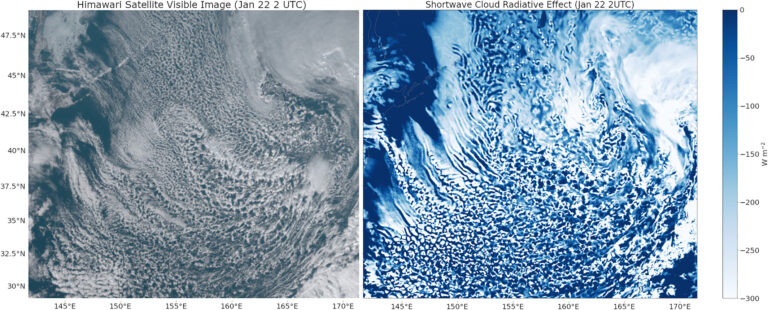SCREAM featured on the cover of JAMES

Figure 1. JAMES cover depicting a hurricane off the west coast of Australia on Feb 16th, 2020 at 0 UTC as simulated by SCREAM at 3.25 km resolution.
First results using the Simple Cloud-Resolving E3SM Atmosphere Model (SCREAM) were recently published in JAMES (Caldwell et al, 2021) and an image from SCREAM was chosen for the journal’s November 21, 2021 issue cover. As described in this highlight, SCREAM is a new convection-permitting global atmosphere model written in C++/Kokkos for performance on both Central Processing Unit (CPU) and Graphics Processing Unit (GPU) architectures.
The JAMES cover (Fig. 1) features a near-global view of SCREAM’s clouds on its right side and a 3d close-up of a hurricane on the left. Within the hurricane, cloud liquid mass is shown in hues of blue and and ice mass is shown in red. Darker hues indicate denser clouds and specific humidities less than 0.001 g/kg are ignored. This image was created by Brad Carvey of Sandia National Lab.
The paper introduces the new model, describes its governing equations, and demonstrates that a prototype version faithfully reproduces the current climate. It focuses on a 40 day simulation (January 20 – February 28 of 2020) which was performed as part of the DYnamics of the Atmospheric general circulation Modeled On Non-hydrostatic Domains (DYAMOND) Phase 2 model intercomparison. This simulation’s 3.25 km horizontal resolution globally is 30 times finer than E3SM’s typical resolution. Many longstanding systematic errors in standard resolution GCMs are greatly improved in this simulation. For example, precipitation is greatly improved both in the timing of its diurnal cycle and the distribution of light versus heavy rainfall. The new model also captures the structure of important weather events, such as tropical and extratropical cyclones, atmospheric rivers, and cold air outbreaks (Fig. 2) which are poorly captured by typical GCMs. This paper is the harbinger of a revolution in DOE earth system modeling where unprecedentedly detailed and realistic simulations lead the way to much more accurate predictions.
Publication
Caldwell, P. M., Terai, C. R., Hillman, B., Keen, N. D., Bogenschutz, P., Lin, W., Taylor, Bertagna, Bradley, Clevenger, Donahue, Eldred, Foucar, Golaz, Guba, Jacob, Johnson, Krishna, Liu, Pressel, Salinger, Singh, Steyer, Ullrich, Wu, Yuan, Shpund, Ma, Zender. (2021). Convection‐Permitting Simulations With the E3SM Global Atmosphere Model. Journal of Advances in Modeling Earth Systems, 13(11). https://doi.org/10.1029/2021MS002544
Related Links to the E3SM v2 Code
Contact
- Peter Caldwell, Lawrence Livermore National Laboratory
This article is a part of the E3SM “Floating Points” Newsletter, to read the full Newsletter check:



